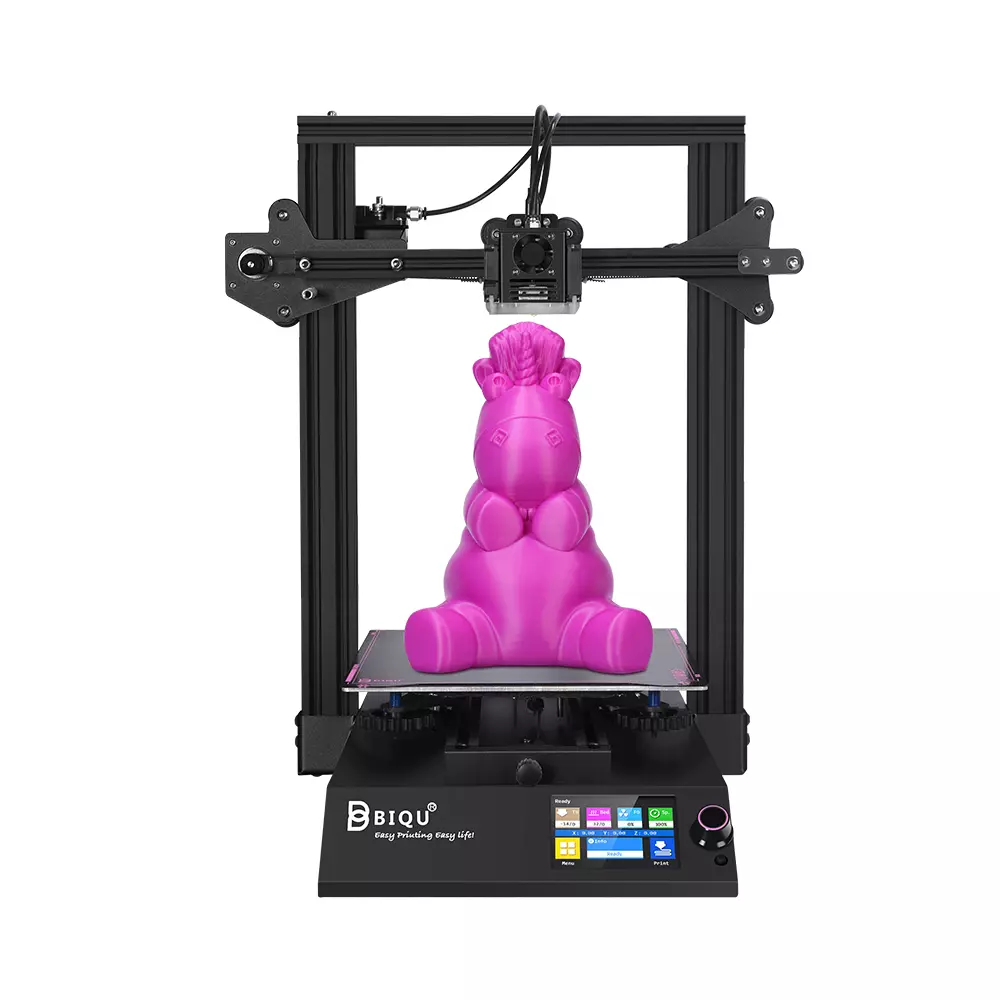Compare Comgrow T300 vs BIQU B1
Comparison between the best 3D printers
Choose the best 3D printer at the best price. The cheapest 3D printers are here.
Buy a 3D printer here with 3D Fila.
 |
 |
|
| Model | Comgrow T300 |
BIQU B1 |
| Printing Material | Filament | Filament |
| Buy Filament for Sovol Comgrow T300 | Buy Filament forBigTreeTech BIQU B1 | |
| Estimated price | $449,00 | $269,00 |
| Manufacturer | Sovol | BigTreeTech |
| Release Year | 2024 | 2020 |
| Print Volume [mm] | 300x300x350 | 235x235x270 |
| Printer Size [mm] | 503x631x831 | 412x402x492 |
| Weight [kg] | 17 | 8,00 |
| Power Loss Recovery | YES | YES |
| Enclosed printer | NO | NO |
| Bed Leveling | Automatic | Manual |
| Filament End Sensor | YES | YES |
| Bed type | Heated | Heated |
| Power supply system | Direct Drive | Bowden |
| Standard nozzle | 0,4 | 0,4 |
| Maximum Nozzle Temperature [°C] | 300 | 250 |
| Maximum Bed Temperature [°C] | 100 | 100 |
| Maximum printing speed [mm/s] | 600 | 100 |
| Filament holder | YES | YES |
| Camera for supervision | NO | NO |
| Recommended filaments | PLA, PETG, PET, TPU, PA, ASA, PC, PLA CE, PA-CF, PET-CF | PLA, TPU, ABS, PETG |
| Recommended slicers | Bambu Studio, Super Slicer, Cura, Prusa Slicer, Orca Slicer | Cura, Simplify, Slic3r |
| Maximum Resolution [mm] | 0,1 | 0,1 |
| Processor | 64 bit | 32 Bits BTT SKR V 1.4 |
| Display | Touchscreen 5'' | Touchscreen TFT 3,5'' |
| Power Supply | 150 W | 24V / 360W |
| Connectivity | USB, WiFi | SD / USB |
| Operating systems | Windows, Linux, Macbook | Windows, Mac, Linux |
| Date of registration in the system | 2024-05-10 | 2021-04-14 |
| Release date | 2024 | 2020 |
| Extra features | The Sovol Comgrow T300 printer stands out for its technological innovations and advanced features. With a print size of 300mm300mm350mm, the T300 offers true linear rails on all axes, ensuring greater stability. Its Klipper-based intelligent core and 64-bit microcomputer increase printing speed and quality through pressure advancement and input shaping. The extruder with a gear ratio of 6.5:1 allows for more precise material control, optimizing the printing of flexible materials. In addition, the T300 features a rapid filament cooling system with a high-speed fan and a circular duct piece that improves cooling efficiency. With a 4.3-inch high-refresh rate touchscreen and an 81-point automatic leveling system, the T300 simplifies the preparation and execution of 3D prints. | The BIQU B1 is an advanced 3D printer with a silent 32-bit BTT SKR V1.4 motherboard and ARM Cortex-M3 CPU, offering DIY interfaces (I2C, SPI, WiFi) and dual Z-axis. Its dual BTT B1 TFT35 V3.0 operating system allows real-time monitoring and multiple printing modes, including G-code visualization effects. It stands out for its BIQU SSS (Super Spring Steel), ensuring easy model adhesion and simplified removal, with the possibility of using it on both sides. It includes a filament sensor, automatically pausing printing in case of filament breakage. The multicolored RGB lights integrated into the hotend allow you to view the printing status even at night. Additional notes include the need for a BIQU-specific Type-C cable and extra interfaces for smart filament sensor and BL Touch. |
| Support for multiple colors and materials (AMS and CFS) | NO | NO |
Notes * |
||
| Cost-benefit | 8 / 10 | 7 / 10 |
| Hardware | 3.6 / 10 | 2 / 10 |
| Tela | . | . |
| Print volume | 4 / 10 | 3 / 10 |
| Performance | 5 / 10 | 1 / 10 |
Conclusion |
| In comparing the Comgrow T300 and the BIQU B1 3D printers, several key aspects emerge that can help potential buyers make an informed decision based on their specific needs and preferences. The Comgrow T300, released in 2024, stands out with its larger print volume and advanced features, such as a 64-bit processor, automatic bed leveling, and a focus on high-speed printing. Its high maximum printing speed and the ability to handle a wider variety of filament types suggest that it is well-suited for users looking to undertake ambitious and complex projects with improved precision and efficiency. Additionally, the T300's innovative cooling system and notable weight indicate a robust build, aiming to enhance printing quality and stability. On the other hand, the BIQU B1, introduced in 2020, offers a solid, budget-friendly alternative. While it has a smaller build volume and a lower maximum printing speed, it still provides essential features such as a heated bed, filament sensor, and a dual Z-axis for enhanced stability. Its user-friendly interface and additional features like RGB lights make it an attractive choice for beginners or those who prefer a straightforward experience without the complexities of more advanced printers. When considering price, the T300's higher cost reflects its advanced technology, increased capabilities, and newer release date, making it more appealing for serious hobbyists or professionals requiring exceptional performance. In contrast, the BIQU B1 provides good value for entry-level users or those with lighter printing needs, balancing performance and affordability. Ultimately, the decision between the Comgrow T300 and the BIQU B1 comes down to individual requirements: if you're seeking higher capabilities and are willing to invest more for advanced features, the T300 would be the better option. However, if cost-efficiency and simplicity are your priorities, the BIQU B1 remains a compelling choice for effective and reliable 3D printing. |

